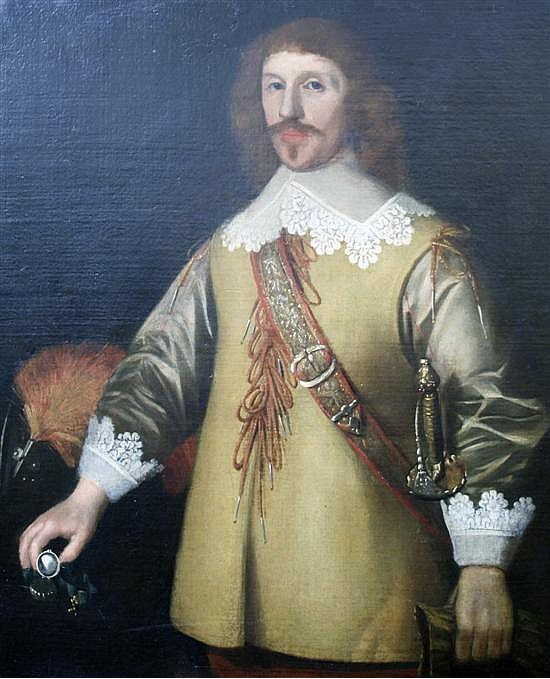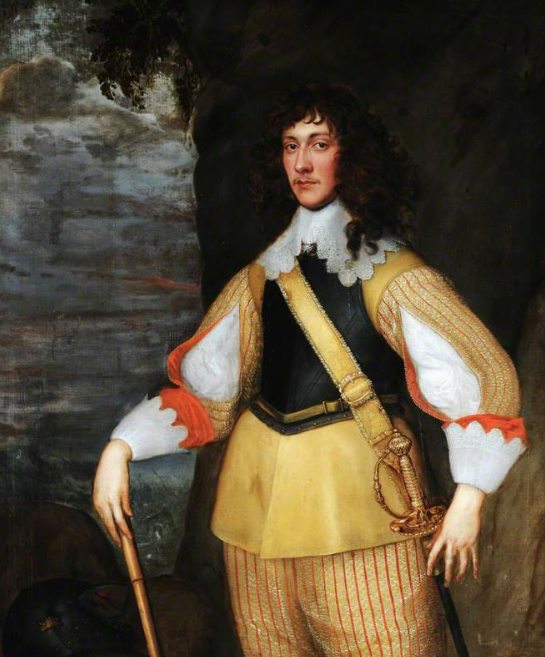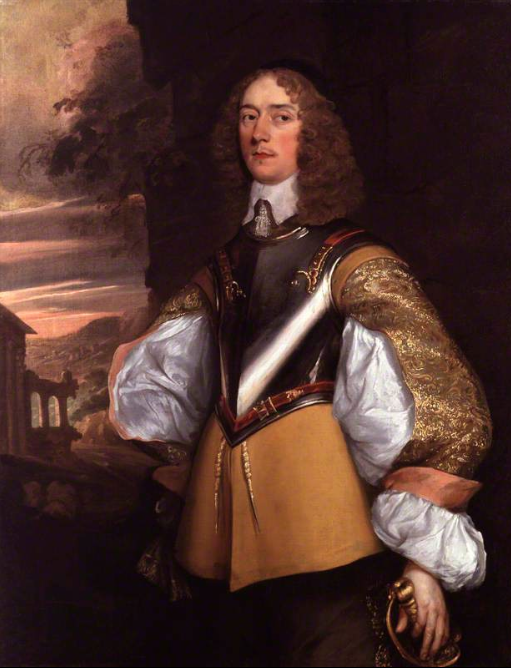February 4, 2014
Painted by an unknown artist shortly after 1650, this is a study of Charles and his Secretary at War Edmund Walker, ostensibly on campaign. The poses are staged in a tableau of Charles dictating a despatch, or maybe a proclamation to go to the printers. It’s such a static scene that it almost looks like a wax work, though notice all the subtle differences, not just in the poses, but also the clothes they are wearing that mark Charles out as the leader and Sir Edmund as the follower
Both men are wearing the blue ribbon as members of the Order of the Garter. They are both also oddly colour coordinated with each other, wearing blue doublet and breeches embroidered with gold thread, though the King’s doublet is more finely figured. Their buff coats match, though again Charles’s is more highly decorated. Edmund’s linen is plain whilst the King’s is edged with lace. He is also sporting a gilded breastplate. The picture hangs in the NPG in London and is © National Portrait Gallery.

Posted in Military, Upper class |
Leave a Comment »
November 29, 2013
This painting came up for auction in 2008 at Gorringes Auction House in Lewes and has been attributed to John Souch. It certainly looks like the style of the portrait painter from Chester and the clothes worn by the officer are spot on for the period. He is wearing a thick leather buff coat laced together down the front with silk satin sleeves seemingly laced in to the coat rather than attached to an underlying doublet. His falling band and cuffs are neat with matching lace edges and his sword hangs from a nicely embroidered baldrick. The magnificent plume on the helmet beside him nicely matches the colours of his lacings and the edges of his baldrick.

Posted in Military, Upper class |
Leave a Comment »
September 6, 2013
We’ve already met Charles Cavendish, the dashing Royalist officer in a painting held at Hardwick Hall in Derbyshire. This portrait also hangs there and is in many respects identical to the first one, but here Charles is a bit older and presumably more experienced in battle than his younger counterpart. He is wearing the same short buffcoat and breastplate, the sword is still there and oddly his hair style is identical (though I wouldn’t have expected a flattering portrait to show any grey hairs that had resulted from his military service). There is no waist scarf now and the braid on his sleeves runs vertically rather than horizontally with the large cuff turn-backs showing a rather nice red silky lining. His sword now hangs from a shoulder baldrick rather than a waist belt, and his falling band and cuffs are edged with lace instead of the plain ones he wore previously.
The main difference is the look he’s giving us from the picture. That’s the look of a man who has seen things he’d rather not have I feel. Not quite the hundred yard stare but definitely the effects of war.

Posted in Military, Upper class |
4 Comments »
July 22, 2013
Painted in or around 1634 by John Souch, Pelham fought in the civil war for the royalist side and was captured at Shrewsbury. Here he is pictured in a fine embroidered or brocade white doublet, (although the sleeves could be separate and held in place by the parti-coloured strings on his shoulders) a long buffcoat with silver decoration, red breeches with pointed decoration, and a fine pair of white, soft leather high-heeled boots. He also has a fine feathered hat, a nice pair of gauntlets, a wide gorget around his neck and he is holding a leading staff, the kind of polearm that looks good but actually isn’t that much use on the field of battle. It’s a badge of rank rather than a weapon. The portrait is held somewhere in an unnamed private collection.

Posted in Military, Upper class |
1 Comment »
May 29, 2013
Second son of the William Fiennes, the 1st Viscount Saye and Sele, Nathaniel had a mixed war on the Parliament side. He was elected MP for Banbury in 1640 and took part in several actions early on and fighting with distinction at Edgehill. Later he found himself embroiled in a political argument following his surrender of Bristol to Prince Rupert’s forces in 1643. He made a spirited defence of his actions for which he was really not at all at fault, but following this he retired from public life for the rest of the first civil war. This rather splendid portrait was painted during the war by Michiel Jansz van Miereveldt and hangs still in the Great Hall of Broughton Castle near Banbury, the ancestral home of the Fiennes family and is copyright Martin Fiennes.
Nathaniel wears clothes that at first sight are understated but if you look closely it’s real quality stuff. The sleeves and skirt of his buff coat are officer thickness. I’ve seen surviving ordinary trooper’s versions and the leather is much thinner. Pay close attention also to the scalloped edges on the over sleeves. His orange parliamentarian scarf is silk, and decorated with a thin stripe of silver thread embroidery. His falling band has been and tied down for action with the bandstrings, but notice the detail on the tassels. That’s not simple work either. The lace on his band is matched with his cuffs. His breast plate and righthand gauntlet are decorated with gilt rivets as is the helmet hanging beside him. Last but not least, his sword is a serviceable mortuary hilt rather than a rapier, but the handle is wrapped with gold wire.
Update. There are, as pointed out by two commenters, a set of tassets or leg protectors peeping out from below his buffcoat at the very bottom of the portrait. This makes no sense at all, you could never sit on a horse as Nathaniel would have done with armour that reached so low. Perhaps the artist began the picture with full armour, in common with a lot of military portraits of the age and for whatever reason changed to a picture that was more representative of what was worn on the battlefield, but omitted to paint out the leg armour?

Posted in Military, Upper class |
3 Comments »
March 4, 2013
of the Red Regiment London Trayned bands, painted in 1644. I can’t find anything about this painting or where it is now, but I do know a little about the good Captaine who was a leading member of the London Company of Plaisterers before and after the war. He fought in at least one battle during the war and maintained his interest in all things military after the war as a member of the Honourable Artillery Company, (the oldest regiment in the Army which continues to provide reservists for HM Forces right up to today), rising to the rank of Lieutenant Colonel. Captaine Stanyan is dressed in his military buff coat which has some gold thread decoration on the seams of the sleeves and decorative clasps up the centre closing. He has plain but serviceable gauntlets and a splendid silk scarf tied at the shoulder, a practical arrangement that keeps the knot out of the way. His collar band is interesting too, seemingly a double layer of linen, each lined with narrow lace. I don’t usually comment on weaponry, but Stanyan has a pole axe or war hammer head on his pole arm and a short flintlock pistol suspended from his coat.

Posted in Military, Upper class |
Leave a Comment »
March 1, 2013
This painting is attributed to Dobson and shows the young prince, younger than he was when painted by William Dobson for the portrait that is better known. He is dressed as a soldier with buff coat over a slashed silk doublet, but the whole effect is riches, brocaded silk breeches, wide laced collar and soft boots with boothose to match his breeches. He’s holding a broad brimmed hat with a white ostrich plume and ribbon favour. There is an odd detail on the right hand, a silk scarf end has been painted but the scarf doesn’t seem to go anywhere. Perhaps it is just knotted around his arm or maybe it’s a mistake. This picture hangs in Kinloch Castle on the Isle of Rum

Posted in Upper class |
2 Comments »
February 5, 2013
The cousin of the more famous Thomas Fairfax, Sir William also fought with distinction on the Parliament side during the war. Here he is painted, possibly by Edward Bower in an outrageous black taffeta scarf in front of his campaign tent, a typical battle scene in the background. He’s wearing a sleeved buffcoat and armour ready for war, but his accessories are just a bit too over the top for action. The picture hangs in the National Trust property Hatchlands, near Guildford.

Look at the metallic threads in the ribbons decorating his grey breeches and the end of his scarf, not to mention the perfectly starched linen double-layered white boot hose and spotless boots.

This detail shows clearly the thickness of leather in his buff coat and the gilding on the fixings of his armour. You can also see the butt joined seam on the coat sleeve.

Plain gauntlets agreed, but spot the metallic fringes.

And just outside the battle rages on. He’s not been near a battle in this get up. I’d put money on it!

Posted in Military, Upper class |
3 Comments »
January 21, 2013
Painted in 1638 by Cornelis Janssens van Ceulen. Grey was a parliamentary officer who fought all through the war. Here he is painted in a round frame, looking just over our left shoulder as we look at him, in a military buffcoat and gorget over which is a fine linen falling band with wide lace. The fabric is almost fine enough to be see through, but not quite. His coat is secured with a profusion of gold laces and he’s also wearing a white, possibly linen doublet with slashed sleeves.

Posted in Military, Upper class |
1 Comment »
January 11, 2013
Painted by John Weesop in the 1640s, this picture is in the National Portrait Gallery. Gage was a career soldier, having fought before the Civil War in the Low Countries and supported the King’s cause from Flanders until 1644 when he moved to Oxford and formed his own regiment. Hs most famous action was the relief of Basing House in September of that year. Sir Henry wears a leather buffcoat with cloth sleeves sumptuously embroidered with gold thread, plain falling band and highly polished, “studio” armour. The slashes in his sleeves make it obvious exactly how much fabric there is in his shirt, always a sign of quality.

Posted in Military, Upper class |
Leave a Comment »













